Explanatory Memorandum
(Circulated by authority of the Treasurer, the Hon Peter Costello, MP)Chapter 5 - Transfer or creation of assets by companies that are members of linked groups
Outline of Chapter
5. 1 Schedule 4 to this Bill inserts new Subdivision 170-D into the ITAA 1997. Subdivision 170-D will defer recognition of a capital loss or a deduction which would, apart from the Subdivision, be realised where there has been:
- •
- the transfer of a CGT asset between companies in the same linked group;
- •
- the creation of certain rights or options in a company in the same linked group as the creator company;
- •
- the transfer of a CGT asset to, or the creation of certain rights or options in, a trust (or an associate of the trust) connected with a member of a linked group; or
- •
- the transfer of a CGT asset to, or the creation of certain rights or options in, an individual (or an associate of the individual) connected with a member of a linked group.
5.2 The deferred capital loss or deduction will only become available to the company that has disposed of or created the asset where, broadly, that company, or the CGT asset involved, ceases to belong to the same linked group (together with connected entities and their associates).
5.3 Broadly, 2 companies are linked to each other if one of them has a controlling direct or indirect stake in the other or the same entity has a controlling stake in each of them.
Context of Reform
5.4 Loss duplication arises when a single economic loss is recognised by the taxation system more than once. This can occur because losses (realised or unrealised) in an entity are reflected in the value of interests (such as shares) in that entity.
5.5 Loss cascading, which is a form of loss duplication, occurs where a loss is artificially duplicated through a chain of companies so that multiple losses are allowed to the same group in respect of a single economic loss. This is facilitated by, among other things, the existence of asset roll-over concessions applying to wholly-owned groups of companies and the ability of groups of companies in general to realise losses (or deductions) by internal transactions.
5.6 For example, a loss may be cascaded where a loss asset (an asset carrying an unrealised loss) is disposed of within a wholly-owned company group. Where this occurs, Subdivision 126-B of the ITAA 1997 may allow a capital loss which would otherwise have been realised on the disposal to be claimed by the transferee when the asset is subsequently disposed of outside the group.
5.7 Subdivision 126-B may therefore effectively allow capital loss transfers between group companies without any of the anti-loss duplication cost base adjustment measures applying on the transfer of realised net capital losses. It may also allow non-residents (including controlled foreign companies) that are specifically prohibited from transferring net capital losses and tax losses to do so indirectly via loss asset transfers. This potentially allows an unrealised loss to be cascaded on interests held directly or indirectly in the transferor company.
Company A capitalises Company B with $100. Company B purchases an asset for $100. The asset declines in value until it is worth $10. Company B transfers the asset to Company C, another wholly-owned subsidiary of Company A. Under Subdivision 126-B, the capital loss that Company B would make on the transfer of the asset is disregarded and the cost-base and reduced cost base of the asset is rolled-over to Company C. Company C now has an asset with an unrealised loss of $90. Company As equity in Company B is worth $10. Company A could sell Company B and realise a capital loss of $90. Company C can sell the loss asset and duplicate the loss.
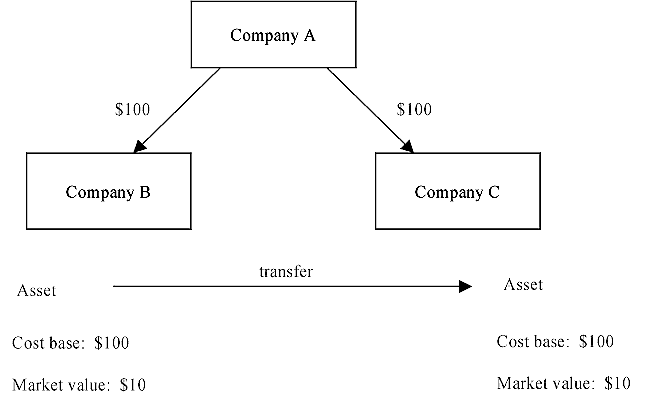
5.8 Loss cascading is not limited to wholly-owned company groups. It can also occur within majority-owned groups, although the mechanism does not involve the roll-over of unrealised loss assets. For example, losses may be obtained on certain transfers of interests in loss entities within less than 100% owned groups where these losses duplicate losses later claimed in the entities themselves. The fact that there are currently no specific restrictions on companies realising losses and deductions on the transfer or creation of assets within majority-owned groups increases cascading opportunities for such groups.
5.9 The deficiencies in the existing law outlined above are to be addressed by ensuring that the transfer or creation of a loss asset by one company to, or in, another in a majority-owned or wholly-owned company group, or by a company in such a group to a connected individual or trust (or an associate of one of these), does not give rise to a capital loss or deduction that can be immediately utilised for tax purposes. The deferred capital loss or deduction will only become available to the company that has transferred or created the asset where, broadly, that company, or the CGT asset involved, ceases to belong to the same linked group (together with connected entities and their associates).
5.10 One of the effects of the proposed amendments is that wholly-owned company groups will have to use the tax loss and net capital loss transfer provisions if they want to group a net capital loss or tax loss. As a consequence, resident companies will not be able, by transferring loss assets, to bypass the anti-loss duplication measures proposed in this Bill (Schedule 5, Subdivision 170-C) for net capital loss and tax loss transfers. In addition, non-resident companies (including controlled foreign corporations) within wholly-owned groups will no longer be able to obtain effective net capital loss or tax loss transfer (which they are denied) via the transfer of an unrealised loss asset.
5.11 The new law will also ensure that balancing adjustment roll-over will not apply in a situation where Subdivision 170-D applies. In these cases, the deduction will be deferred to the transferor company. The new law will not impact on the roll-over of balancing adjustments where the adjustment would otherwise involve the inclusion of an amount in assessable income.
5.12 New Subdivision 170-D is consistent with the policy approach outlined in recommendation 6.11(b) of A Tax System Redesigned .
Summary of new law
5. 13 Broadly, Subdivision 170-D will apply where:
- •
- a company disposes of an asset to, or creates an asset in;
- -
- another company; or
- -
- a connected entity or its associate;
- •
- the company disposing of or creating the asset (the originating company) and the company receiving the asset (where relevant) are members of the same linked group; and
- •
- the disposal or creation of the asset would, apart from the operation of Subdivision 170-D, generate a capital loss or a deduction for the originating company.
5.14 Where these conditions are met, the capital loss or deduction that would otherwise be available on transfer will be deferred. [Section 170-250]
5.15 The deferred capital loss or deduction will only become available to the company that has disposed of or created the asset where, broadly, that company, or the CGT asset involved, ceases to belong to the same linked group (together with connected entities and their associates).
Detailed explanation of new law
When is a company required to defer recognition of a capital loss or deduction?
5.16 A company will be required to defer recognition of a capital loss or deduction that arises from a deferral event involving a company (the originating company ) and another entity [paragraph 170-255(1)(a)] . Where a company is a partner in a partnership, and an event happens between the partnership and another entity, the company is involved in the event for the purposes of Subdivision 170-D.
5.17 Deferral of recognition means disregarding a capital loss or deduction that would, apart from the operation of Subdivision 170-D, become available on the happening of a specified deferral event. The capital loss or deduction that is disregarded is deferred until a further specified event happens. When that event happens, the capital loss or deduction is able to be utilised by the originating company.
5.18A deferral event happens if a prescribed CGT event (in paragraph 5.25) would have resulted in the originating company making a capital loss on the disposal of a CGT asset to the other entity, or the creation of a CGT asset in the other entity. However, where a capital loss is made but is disregarded, apart from Subdivision 170-D, then Subdivision 170-D will not apply. [Subparagraph 170-255(1)(b)(i)]
5.19 A deferral event also happens if the originating company would have become entitled to a deduction as a result of the disposal of a CGT asset to the other entity. [Subparagraph 170-255(1)(b)(ii)]
5.20 In addition, a deferral event happens if the originating company is a partner in a partnership and the partnership would have become entitled to a deduction as a result of the disposal of a CGT asset to the other entity. [Subparagraph 170-255(1)(b)(iii))]
5.21 A partners share of the deduction refers to a partners individual interest in the net income or partnership loss relating to the deduction that the partnership would have become entitled to as a result of the deferral event. Ordinarily the partners share of that deduction will be the same as the partners interest in the overall net income or partnership loss, unless the partnership agreement suggests that a different proportion is appropriate.
5.22 For example, assume there is a partnership loss of $1,000 of which $700 relates to a deduction that the partnership would have become entitled to as a result of the deferral event. If the partners individual interest in the partnership loss is 25%, then $175 of the deduction the partner would otherwise have made is disregarded.
5.23 Subdivision 170-D will not apply to the disposal of trading stock. This is because of the interaction of the conditions required for Subdivision 170-D to apply with the way that deductions and assessable income are accounted for under the trading stock provisions of the law, and because of the treatment of trading stock under the CGT provisions of the law.
5.24The originating company must be a member of a linked group at the time of the deferral event. In addition, the other entity must be either:
- •
- another company in the same linked group; or
- •
- a connected entity in relation to the originating company or an associate of the connected entity.
In the case of a partnership, the relevant entity will be a partner in the partnership.
5. 25 The CGT events which are relevant for the purposes of Subdivision 170-D are as follows:
- •
- CGT event A1 the originating company disposes of the asset to the other company, connected entity or an associate of the connected entity. Disposal occurs where ownership of the asset passes from the originating company to the other company, connected entity or its associate. [Subparagraph 170-255(1)(c)(i)]
- •
- CGT event B1 the originating company enters into an agreement with the other company, connected entity or associate of the connected entity by which the use and enjoyment of the asset passes to the other company, connected entity or associate. At the end of the agreement, title in the asset must pass to the other company, connected entity or associate of the connected entity. [Subparagraph170-255(1)(c)(i), subsection 170-255(2)]
- •
- CGT event D1 the originating company creates a contractual right or other legal or equitable right in the other company, connected entity or associate of the connected entity. [Subparagraph170-255(1)(c)(ii)]
- •
- CGT event D2 the originating company grants, renews or extends an option to the other company, connected entity or associate of the connected entity. [Subparagraph170-255(1)(c)(ii)]
- •
- CGT event D3 the originating company owns, or owns an interest in, a prospecting entitlement or mining entitlement and the originating company grants a right to the other company, connected entity or associate of the connected entity to receive income from operations carried on because of the entitlement. [Subparagraph170-255(1)(c)(ii)]
- •
- CGT event F1 the originating company grants, renews or extends a lease for the other company, connected entity or associate of the connected entity. [Subparagraph 170-255(1)(c)(ii)]
5. 26 In addition, Subdivision 170-D will only apply where one of the following is satisfied:
- •
- at the time of the deferral event, the originating company is a resident of Australia;
- •
- for CGT events A1, B1, or F1, the relevant asset had the necessary connection with Australia immediately before the deferral event;
- •
- for CGT event D1, the proceeds from the CGT event are, or would be, Australian sourced; or
- •
- for CGT event D2, the option had the necessary connection with Australia immediately after the deferral event.
5. 27 If the deferral event is CGT event D3, Subdivision 170-D will only apply where the originating company is a resident. This is because section 136-20 of the ITAA 1997 provides that a non-resident cannot make a capital gain or capital loss from CGT event D3.
Bigco and Smallco are companies in the same linked group. Bigco owns a CGT asset with a cost base of $100 and a market value of $50. On 1 January 2000 Bigco sells the asset to Smallco for $50.
Subdivision 170-D requires that the capital loss of $50 which Bigco would otherwise make on the sale of the asset be deferred because both companies are members of the same linked group.
5. 28 To determine whether Subdivision 170-D applies, it will be necessary to identify a linked group and, if necessary, a connected entity of the originating company or an associate of the connected entity. The rules for determining whether a company forms part of a linked group, or whether an entity is connected with an originating company, are discussed in paragraphs 5.29 to 5.40.
5. 29 Two companies are linked to each other if one of them has a controlling stake in the other or the same entity has a controlling stake in each of them. [Subsection 170-260(2)]
What is a controlling stake in a company?
5. 30 An entity has a controlling stake in a company at a particular time if the entity either alone or with its associates has at least one of the following:
- •
- the ability to exercise, or control the exercise of, more than 50% of the voting power in the company (either directly or through an interposed entity or entities);
- •
- the right to receive (either directly or through an interposed entity or entities) for their own benefit more than 50% of any dividends that the company may pay; or
- •
- the right to receive (either directly or through an interposed entity or entities) for their own benefit more than 50% of any distribution of capital of the company.
5. 31 A wholly-owned group of companies will also be a linked group for the purposes of Subdivision 170-D.
5. 32 For the purposes of Subdivision 170-D, associate takes its meaning from section 318 of ITAA 1936 .
Rules for avoiding the double counting of interests
5. 33 There exists the potential for double-counting of an entitys interest because both direct and indirect interests of the entity and its associates are taken into account in determining whether a company forms part of a linked group. An entity is to ignore an indirect interest which has already been counted in determining a direct interest of the entity (or an associate). [Subsection 170-260(4)]
Individual shareholder A holds 80% of all the shares in Company A and 60% of all the shares in Company B. Company A and Company B form a linked group because individual A has a controlling stake in each of them.
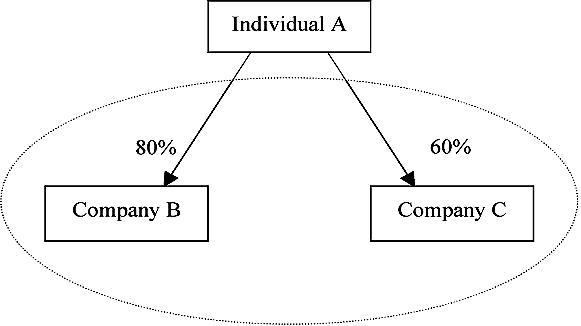
Headco holds 80% of the shares in Subco-1. Subco-1 holds 51% of the shares in Subco-2. Headco, Subco-1 and Subco-2 form a linked group. Headco has a controlling stake in Subco-1. Headco also has a controlling stake in Subco-2, by virtue of Subco-1 (which is an associate of Headco).
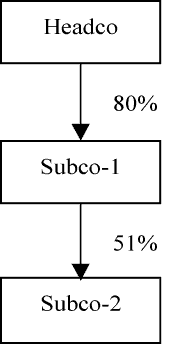
Trust A is a widely held fixed (unit) trust. The trustee of Trust A holds 100% of the shares in A-co and 60% of the shares in B-co. B-co holds 40% of the shares in C-co. The trustee of Trust A has a controlling stake in A-co and B-co. A-co and B-co are also both associates of the trustee of Trust A. The trustee of Trust A and its associates do not, however, have a controlling stake in C-co. Therefore the linked group is made up of A-co and B-co only.
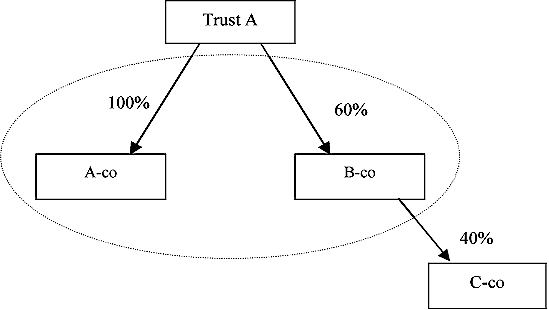
Headco holds 100% of the shares in A-co and 80% of the shares in B-co. A-co holds 30% of the shares in C-co. B-co holds 40% of the shares in C-co. Headco and A-co are linked as are Headco and B-co because Headco has a controlling stake in each of them. A-co and B-co are also linked. Headco can control (indirectly via A-co and B-co) 70% of the voting power of C-co.
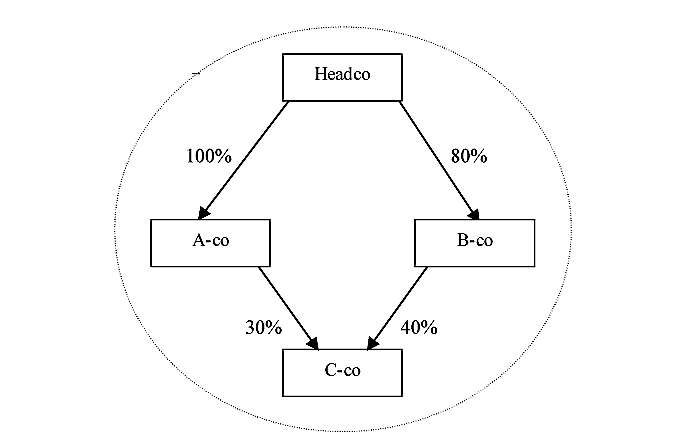
Company A owns 30% of Company B and 30% of Company C. Company B owns 70% of Company C. Company B forms part of the same linked group as Company C. Company As interest in Company C is calculated by aggregating Company As direct and indirect interests in C. Company As indirect interest in Company C is calculated by multiplying 30% by 70%. Company As indirect interest in Company C is 21%. Company As direct interest in Company C is 30%. Company As interest in Company C is the sum of Company As direct and indirect interests, Company As interest in Company C is 51%. Company C forms part of the same linked group as Company A.
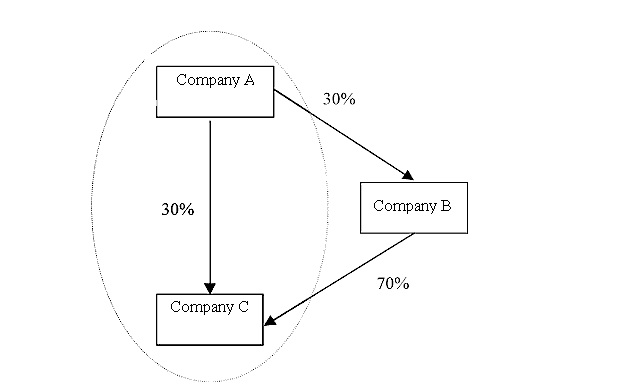
Company A has a controlling stake in Company B such that Company A and Company B form a linked group. Company B is also an associate of Company A. Company A and Company B also hold shares in Company C. It is assumed that Company C is not an associate of Company B.
Company A has a direct interest in Company C of 10% and an indirect interest of 15% (51% of 30%). Company B has a direct interest in Company C of 30%. The total of these interests is 55%.
However Company As indirect interest has already been counted in counting Company Bs interest. Therefore the indirect interest is disregarded. The aggregate interests of Company A in Company C is 40%. Company C does not form part of the linked group of which Company A and Company B are members.

5.34 Capital losses and deductions will be deferred where a member of a linked group originating company disposes of a CGT asset to, or creates a CGT asset in (in the case of capital losses), a connected entity or its associate.
5.35 A connected entity in relation to an originating company at a particular time is:
- •
- a trustee of a connected trust (where the trustee is acting in its capacity as such); or
- •
- an individual who has a controlling stake in the originating company.
5.36 A connected trust can either be a fixed trust or a trust that is not a fixed trust. A trust is a fixed trust if persons have fixed entitlements to all of the income and corpus of the trust. [Item 4 of Schedule 10 - Section 995-1]
5.37 A fixed trust will be a connected trust at a particular time if one or more members of the linked group that the originating company belongs to, or those members and their associates, have between them the right to receive as beneficiaries more than 50% of any distribution of the income or the corpus of the trust. [Subparagraph 170-265(1)(a)(i)]
5.38 Where the trust is not a fixed trust, it will be a connected trust at a particular time if a member of the linked group, or an associate of the member, benefits or is capable of benefiting under the trust. [Subparagraph 170-265(1)(a)(ii)]
5.39 An individual has a controlling stake in a company at a particular time if the individual either alone or with its associates has at least one of the following:
- •
- the ability to exercise, or control the exercise of, more than 50% of the voting power in the company (either directly or through an interposed entity or entities);
- •
- the right to receive (either directly or through an interposed entity or entities) for their own benefit more than 50% of any dividends that the company may pay; or
- •
- the right to receive (either directly or through an interposed entity or entities) for their own benefit more than 50% of the distribution of capital of the company.
5.40 The double-counting rules discussed in paragraph 5.33 are of equal relevance in determining whether an individual has a controlling stake in a company. [Subsection 170-265(3)]
Companies A, B and C form a linked group. Company A is an originating company. Company B is an object of a discretionary trust, Trust A. Trust A is a connected trust of Company A.

Companies A, B and C form a linked group. Company C is an originating company. Company A holds 60% of the units in a unit trust. The unit trust is a connected trust of Company C.
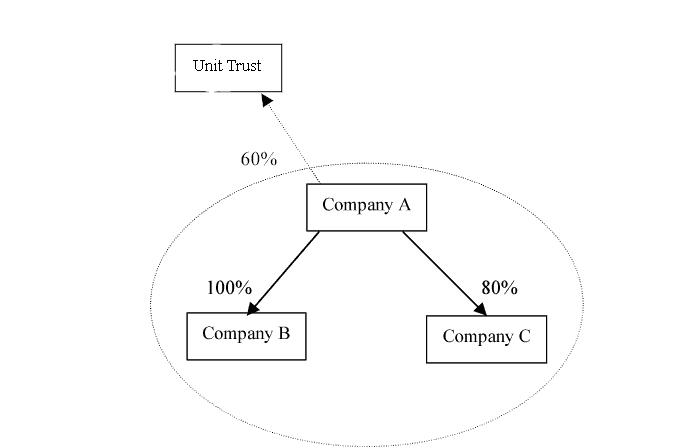
When can an originating company utilise a deferred capital loss or deduction?
5.41 Where the originating company would have made a capital loss or become entitled to a deduction as a result of a deferral event in relation to a CGT asset, the capital loss or deduction which it would otherwise be entitled to is disregarded. Where the originating company is a partner in a partnership, and the partnership would have become entitled to a deduction as a result of a deferral event in relation to a CGT asset, the partners share of the deduction is disregarded. [Section 170-270]
5.42 The originating company can only later utilise the capital loss or deduction when, broadly, the CGT asset or the originating company are no longer part of the same linked group (including connected entities and their associates). This will happen in the following circumstances:
- •
- the CGT asset ceases to exist;
- •
- the asset, or a greater than 50% interest in it, is acquired by an entity that is not a member of the same linked group as the originating company, nor a connected entity or an associate of a connected entity. In the case of a partnership, the relevant entity will be a partner in the partnership;
- •
- the asset is owned by a company that is a member of the linked group and that company ceases to be a member of the linked group;
- •
- the originating company ceases to be a member of the linked group; or
- •
- the CGT asset was transferred to or created in a connected entity of the originating company, or an associate of the connected entity, and that entity ceases to be connected with the originating company, or the associate ceases to be an associate.
5.43 When one of these events occurs, the originating company is taken to have made a capital loss or deduction equal to the amount of the deferred capital loss or deduction. The capital loss or deduction will be taken to have been realised immediately before the relevant circumstance occurred. [Subsection 170-275(1)]
Oldco and Newco are companies in the same linked group. Oldco has a revenue asset with a cost price of $200 and a market value of $100. On 1 December 1999 Oldco sells the asset to Newco for $100. On the sale of the asset Oldco realises a potential deduction of $100.
Oldco cannot utilise this deduction because Newco is part of the same linked group.
On 1 March 2000 Newco sells the asset to Ethel. Ethel is an individual unconnected with the group. On the sale of the asset to Ethel, Oldco can utilise the deferred deduction of $100.
Loss retains character in hands of the originating company
5. 44 If the CGT asset subject to the deferral event is a personal use asset or a collectable, then the capital loss which the originating company would have made retains its character as a loss made from a personal use asset or collectable when the capital loss subsequently becomes available for utilisation. [Subsection 170-275(2)]
Restriction on the realisation of a deferred capital loss or deduction
5. 45 Where a capital loss or deduction has become available to the originating company because of the occurrence of a new event in respect of a CGT asset (set out in section 170-275), and within 4 years after the happening of the new event the asset, or a greater than 50% interest in it, is acquired by:
- •
- an entity which is a connected entity (or an associate of the connected entity) in relation to the originating company at the time the asset is acquired by the connected entity (or associate); or
- •
- a company (including the originating company) that is a member of the same linked group as the originating company group at that time,
then the capital loss or deduction made at the time of the new event is taken not to have been made. [Subsections 170-280(1) and 170-280(2)]
5. 46 The capital loss or deduction becomes a deferred capital loss or deduction and is only capable of being utilised when one of the following circumstances happens:
- •
- the CGT asset ceases to exist;
- •
- the asset, or a greater than 50% interest in it, is acquired by an entity that is not a member of the same linked group as the originating company, nor a connected entity or an associate of a connected entity. In the case of a partnership, the relevant entity will be a partner in the partnership;
- •
- the asset is owned by a company that is a member of the linked group and that company ceases to be a member of the linked group;
- •
- the originating company ceases to be a member of the linked group; or
- •
- the CGT asset was transferred to or created in a connected entity of the originating company, or an associate of the connected entity, and that entity ceases to be connected with the originating company, or the associate ceases to be an associate. [Subsection 170-280(3)]
Application and transitional provisions
5. 47 The amendments made by Schedule 4 apply to deferral events happening on or after 21 October 1999. [Subitem 19(1) of Schedule 4]
Consequential amendments
Income Tax Assessment Act 1997
5.48 Item 1 of Schedule 4 makes a consequential amendment to Subdivision 41-A of the ITAA 1997. Subdivision 41-A contains common rule 1 for capital allowances (dealing with roll-over relief for related entities). The amendment will ensure that where Subdivision 170-D applies to a CGT event or disposal, Subdivision 41-A will not apply.
5.49 Items 4 to 13 of Schedule 4 make consequential amendments to Subdivision 126-B of the ITAA 1997. Subdivision 126-B deals with the roll-over of CGT assets between companies in the same wholly-owned group. Broadly, the amendments reflect that new Subdivision 170-D now deals with capital losses and deductions which would otherwise be realised where a CGT asset is disposed of or created within a wholly-owned group. Thus, Subdivision 126-B will generally no longer have application where Subdivision 170-D applies.
5.50 Item 4 repeals existing paragraph 126-55(1)(a) and inserts new paragraph 126-55(1)(a) and (aa). These paragraphs have the effect of confining roll-over under Subdivision 126-B to situations where:
- •
- the originating company would otherwise make a capital gain;
- •
- the originating company would otherwise make no capital loss and would not be entitled to a deduction; or
- •
- the originating company acquired the roll-over asset before 20September 1985.
5.51 Thus, Subdivision 126-B functions as a standard group roll-over provision allowing for the retention of pre-CGT status (including on lossassets otherwise subject to deferral) and for roll-over of gain assets. If the asset would (but for the new deferral rules) have generated a capital loss or a deduction then it cannot be rolled-over under Subdivision 126-B, unless it is a pre-CGT asset (in which case the only effect of the roll-over is to preserve that pre-CGT status).
5.52 Items 5 to 9 make amendments to Subdivision 126-B to omit references to capital losses and to omit provisions relevant only to capital losses. Again, the effect of these amendments is to confine roll-over under Subdivision 126-B to situations where the originating company would make a capital gain or no capital loss or deduction.
5.53 Items 10 to 13 make amendments to section 126-85 of Subdivision 126-B. Currently, section 126-85 allows capital gains and capital losses made by a holding company on the liquidation of its 100% subsidiary to be reduced in certain circumstances where the subsidiary rolls over assets to the holding company in the course of the subsidiarys liquidation. This is to ensure that the gain or loss attached to the roll-over asset is not duplicated on the disposal of the shares in the subsidiary.
5.54 As mentioned at paragraph 5.49, the introduction of Subdivision 170-D means that Subdivision 126-B will no longer apply to assets which would otherwise realise a capital loss. Therefore, it is now highly unlikely that a capital loss could be duplicated where a subsidiary in liquidation transfers a loss asset to the holding company. This is because Subdivision 170-D requires the loss to be deferred in the subsidiary company and not in the holding company.
5.55 In addition, although the capital loss may be realised in the subsidiary before it is dissolved, the transfer of that loss to another member in a wholly-owned group would trigger cost base adjustments affecting the holding companys shares in the subsidiary.
5.56 For these reasons, section 126-85 is amended to ensure that a capital loss on the holding companys shares is not reduced by the section.
5.57 In addition, the method statement in subsection 126-85(3) is amended to ensure that capital losses subject to the rules in Subdivision 170-D are counted in determining the extent of a reduction in a capital gain made by the holding company on cancellation of its shares in the subsidiary.
Income Tax Assessment Act 1936
5.58 Items 16-18 of Schedule 4 make consequential amendments to several provisions of the ITAA 1936.
5.59 Items 16 and 18 ensure that where Subdivision 170-D applies to a disposal, sections 73E and 124PA will not apply.
5.60 Item 17 ensures that, where demutualisation method 6 of the demutualisation of insurance company provisions (contained in Division 9AA) applies to the demutualisation of an entity, then roll-over relief under Subdivision 126-B, as in force prior to the amendments made by items 4 to 13 of Schedule 4, will be available.
Copyright notice
© Australian Taxation Office for the Commonwealth of Australia
You are free to copy, adapt, modify, transmit and distribute material on this website as you wish (but not in any way that suggests the ATO or the Commonwealth endorses you or any of your services or products).
